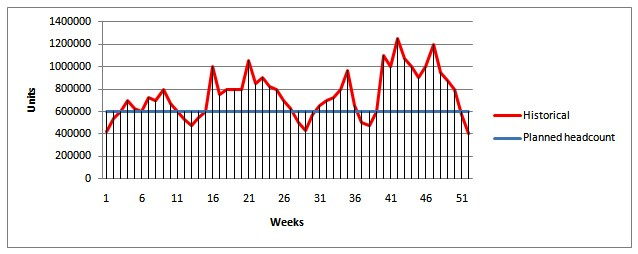As the speed and agility of supply chains evolves, the way in which labour resources are optimised also needs to evolve in order to keep pace with the changing buying behaviours of consumers. South African labour broking laws are also forcing companies to re-think the way they resource their workforce. In addition, when companies add the ability to change where and how products are fulfilled, they also need the ability to flex resources up or down to ensure they have the right number of people to support the real-time changes taking place at the store, in the distribution centres (DCs) and across their fleets.
The distribution workforce has historically been a full-time (often union) and with the advent of labour broking regulations in South Africa this has become more prevalent. So a fixed-shift workforce is now starting to be viewed as a set annual cost. Companies with distribution requirements and their trading partner networks were primarily concerned with employee productivity as opposed to the number of employees needed. Schedules were established and shifts defined on an annual basis and unless there was a significant change to the distribution network, this number did not change with the exception of attrition. The problem with this approach is that a full-time fixed-shift workforce does not mirror the actual need for workers driven by the ever-changing demands placed on the DC.

The figure above represents throughput levels within a retail distribution facility. The red line represents throughput and the blue line represents typical staffing levels. The peaks and valleys created by too little or too much labour present a big challenge to most employers. First, they must predict when the peaks and valleys will occur, then establish the appropriate staffing levels in an effort to minimise the use of temporary workers and overtime. Throughput is unpredictable, however, and is affected by a myriad of forces—economics, training, process, productivity, network change, order size, globalisation, technology, demand volatility and SKU proliferation.
If you have too much labour, your total cost to serve will be excessive and you risk being either unprofitable or non-competitive. If you have insufficient labour, you will either sacrifice service levels or lose valuable sales—neither of which is acceptable in an environment where retailers are fighting for customer loyalty.
In most DCs, labour makes up a significant portion of total costs. If inventory levels are adjusted based on fluctuating demand, shouldn't the variable costs associated with handling that inventory be adjusted as well? Workforce optimisation requires a hierarchy of processes to ensure you have the right balance of full-time, temporary and overtime labour to handle the peaks and troughs in daily operations with the goal being to get the most work done at the lowest possible cost with the highest level of service. The hierarchy is based on a three-step process.
Step1: Strategic Workforce Forecast
The first step in optimising your workforce is to forecast the projected throughput for the year. The inputs to the forecast generally include historical throughput, projected volume increases/decreases, employee productivity, new process improvements and network or facility changes. This exercise provides a forecast that plots the amount of labour required to perform the projected work by day, shift, job and zone. The outputs include an analysis of where there is too much labour and where there is too little, as well as the cost associated with that labour plan. The user can simulate the impact of adding overtime and/or temporary labour to fill the gaps and analyse the most effective balance of full-time, overtime and temporary resources to perform the projected workload.
Forecasting the projected workload and the labour requirements in advance provides visibility to where the projected bottlenecks may occur and enables the user to address issues well in advance.
Step 2: Workforce Schedule Optimisation
The second step in aligning your workforce with actual demand is to schedule labour to optimally handle the inventory at the lowest possible cost. This is generally done on a monthly or even weekly basis to account for the most current demand information. Optimally scheduling your workforce requires taking into account individual employee productivity, labour rates and qualifications, and balancing that against that of other employees to determine the optimal time and activity for each individual. This analysis is more complicated than it may seem. In a typical warehouse with 100 employees and three shifts, the variables run into the millions. Only by leveraging advanced optimisation technology can a company effectively calculate the optimal schedule.
The result is a schedule by employee, by day, by shift, by zone based on what is best for the overall facility.
Step 3: Milestone Workforce Optimisation
The third step involves forecasting and scheduling labour around pre-planned milestones that create a significant impact on demand such as new product introductions, promotions or seasonality. Unique spikes in demand created by event milestones are difficult to quantify. Looking at past history and massaging the data will provide insight into the potential impact and a basis for adjusting regular, overtime and temporary labour. It will also provide the basis for optimizing the scheduling of individual employees to ensure that the new and/or different work can be accomplished in the most cost-effective manner. The result is a labour resource allocation plan that is specifically tailored to the event.
Optimising Labour to the Demand
Bottom line—companies need to allocate resources in alignment with changing levels of throughput and inventory based on demand. Labour, as a key resource and cost within the distribution centre, must be optimised to the demand. To ensure the proper level of labour, companies must address the following:
· Plan and forecast annual workforce budget.
· Establish appropriate level of regular workforce for projected work.
· Optimise the mix of Regular, Overtime and Temporary.
· Plan for seasonal changes, new product introductions and promotions.
· Continually optimise staffing levels by day, shift job and zone.
Contributed by Michael Badwi, Director, Supply Chain Junction